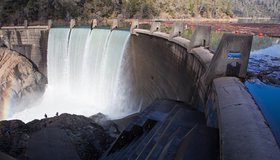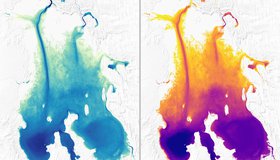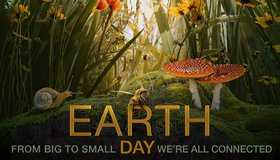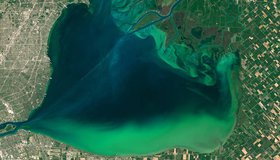
New SWOT Satellite to Survey World's Water
How much water sloshes around in Earth’s lakes, rivers, and oceans? And how does that amount change over time? The upcoming Surface Water and Ocean Topography (SWOT) mission plans to find out.

Our Planet, Our Future
The 2021 Nobel Prize Summit issues an urgent call for action to achieve effective planetary stewardship and global sustainability.

Covering Canals With Solar Panels Could Reduce Emissions, Save Water
A new study finds that covering thousands of miles of California’s canals with solar panels could help the state meet its ambitious goals to reduce greenhouse emissions as well as improve irrigation management.

Sizing up Remote Lakes From Space
Researchers have found a new way to measure the depth of some of the most isolated, shallow lakes, using NASA's ICESat-2 satellite. Knowing the shapes of lake beds in dry regions enables us to better estimate the amount of water stored in these basins.

Using Floodwater to Weather Droughts
Floodwaters aren't what most would consider a blessing. But they could help remedy California’s increasingly parched groundwater systems, according to a new study.

NASA 2021 Water Resources Solicitation
NASA has released a 2021 solicitation for water-resource proposals through NASA's Research Opportunities in Space and Earth Sciences (ROSES). The first-round deadline is May 21, 2021.

Green Lakes From Space
Harmful algal blooms are often hard to predict. NASA's Earth-observing satellites are uniquely poised to help spot them, and track the many ways that different parts of the Earth's system are connected.

We're All Connected
From big to small...we’re all connected. In honor of Earth Day this week, NASA is hosting an Earth Day Virtual Event and releasing a range of activities, live talks, games, videos and great downloadable posters and books.

When The Water Isn't Fine
The Cyanobacteria Assessment Network (CyAN) - a joint EPA, NASA, NOAA and USGS project - uses satellites to monitor harmful algal blooms in over 2,000 of the largest U.S. lakes. Since its launch, CyAN has saved millions of dollars in monitoring and health costs.

Climate Change Devastates Housing Security
In 2020, there were 22 billion-dollar U.S. climate disasters - floods, storms, droughts, heatwaves. One third of U.S. homes are at high risk from natural disaster, with many homeowners bearing the brunt of costly repairs.